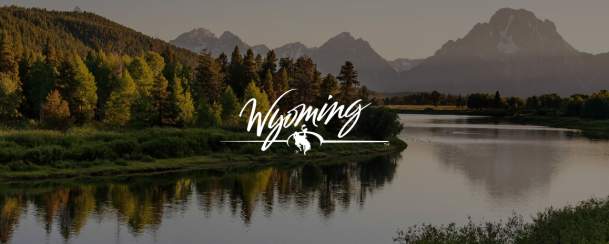When migrants settled in Wyoming in the 1800s, they followed the dusty trails of those who came before them.
Western frontier forts sprang up along these paths to provide weary travelers and railroad workers with food and other supplies. Landmarks were erected to honor the lifestyles and traditions of the time. Quiet remnants of these once-bustling areas remain in Wyoming today — a testament to today’s travelers that the West still lives.
1. Fort Bridger State Historic Site

Where: Near Evanston | Southwest Wyoming
Why Fort Bridger is famous
Fort Bridger is one of the most popular Wyoming landmarks, as it was among the state's earliest and liveliest centers of commerce. The trading post, founded in the early 1800s, was a hub of activity for westward-bound pioneers, Native Americans, U.S. Army personnel, Pony Express carriers and Oregon and Mormon Trail journeyers.
Fort Bridger Today
You can walk among 34 historic structures and re-created buildings — from homestead cabins and a schoolhouse to a Pony Express barn and officers' quarters — that recall the fort's heyday. A museum showcases items from eras past, and costumed guides provide historical details. The fort is one stop along the Bridger Valley Historic Byway, a 20-mile loop that was once a crossroads for the Oregon Trail, the Mormon Trail, the Pony Express Route, the Transcontinental Railroad and the Lincoln Highway.
Things to see near Fort Bridger
- Bear River State Park
- Piedmont Charcoal Kilns Historic Site (in nearby Piedmont)
- Roundhouse and Railyards
2. Connor Battlefield State Historic Site

Where: Co Rd 67, Ranchester, WY 82839 | Northeast Wyoming
Why Connor Battlefield is famous
Tensions between the Plains Indians and white settlers reached a fever pitch in 1865 when General Patrick E. Connor and his soldiers attacked Chief Black Bear’s Arapaho village. A handful of battles ensued in the following days, ending with Connor’s troops being forced out of the area.
Connor Battlefield Today
Visit the site of Black Bear’s camp, home of the battle’s monument and one of the most popular Wyoming’ historical sites. Camping, fishing, and picnicking are popular pursuits in this now peaceful, lush area alongside the gently flowing Tongue River. Connor Battlefield State Historic Site can be found along the Bighorn Scenic Byway, which also crosses the Bighorn National Forest and is packed with river and mountain views, expanses of forest and rangeland, and unique limestone outcroppings.
Things to see near Connor Battlefield
- Gallery In-de-Skies
- T-Rex Natural History Museum
- Dayton Mercantile (in nearby Dayton)
3. Fort Laramie National Historic Site

Where: 965 Grey Roacks Road, Fort Laramie, WY 82212 near Torrington | Central Wyoming
Why Fort Laramie is famous
This 1834 fur-trading post where the North Platte and Laramie rivers converge was in continuous operation for more than 50 years. Like many of Wyoming’s other forts, Fort Laramie was a major stop on the Oregon Trail, but it enjoyed a comparably peaceful existence. The presence of the U.S. Army, there to protect the trail’s wagon trainers, was enough to deter violence.
Fort Laramie Today
The park service offers an audio tour of the fort’s grounds. Hear details about Fort Laramie’s past and the western frontier in general, including passages from residents’ diaries. Uniforms, weapons and other artifacts are on display.
One structure, Old Bedlam, is the oldest standing building in the state of Wyoming.
Things to see near Fort Laramie
4. Fort Fetterman Historic Site

Where: 752 WY-93, Douglas, WY 82633 | Central Wyoming
Why Fort Fetterman is famous
Established as a supply point for the soldiers protecting the Union Pacific Railroad, this late-1800s fort epitomized the Wild West: shootouts, robbings, hangings and famous characters like Wild Bill Hickock, Calamity Jane and Buffalo Bill Cody. Abandoned by the military in 1882, who found its tough winters an impediment to keeping soldiers from deserting, Fort Fetterman evolved into a supply stop for ranchers and wagon trains before being abandoned completely in 1886.
Fort Fetterman Today
Read signs that describe the fort’s past and left-behind structures, including a restored officer’s quarters and an ammunition warehouse, both of which contain exhibits and artifacts.
Things to see near Fort Fetterman
5. Fort Casper Museum
Where: 4001 Fort Caspar Rd, Casper, WY 8260 | Central Wyoming
Why Fort Casper is famous
Fort Caspar was founded on the North Platte River in 1858 and, similar to other Western frontier forts, served as a trading post. Located along the Oregon Trail and featuring a bridge that allowed travelers to cross the river, it was renamed Platte Bridge Station before being taken over by the army a few years later. In 1865, the fort was the site of several deadly battles and was eventually abandoned in 1867.
Fort Casper Today
On the National Register of Historic Places, the Fort Caspar Museum and Historic Site features reconstructed buildings and exhibits that interpret frontier army and overland trail emigration.
Things to see near Fort Casper
- Wyoming Veteran’s Memorial Museum
- Tate Geological Museum at Casper College
- National Historic Trails Interpretive Center
5. Fort Fred Steele State Historic Site

Where: Sinclair, WY 82334 near Rawlins | Southeast Wyoming
Why Fort Fred Steele is famous
Fort Steele was initially established in the late 1860s to protect workers constructing the Transcontinental Railroad in areas prone to conflicts with Indigenous communities. When the rail work was complete, cattlemen, sheepherders, loggers and merchants moved in to settle the territory.
Fort Fred Steele Today
The stories found along the fort’s interpretive trail help paint a picture of its past. The folks at the Wyoming State Parks and Historic Sites describe the military cemetery, ammunition storage, barracks and other remnants as “mute testimony to the flourishing and subsequent passing” of frontiers all over the state.
Things to see near Fort Fred Steele
- Sinclair Golf Club
- Parco/Sinclair Museum
- Seminole State Park
7. Wagon Box Fight State Historic Site
Where: Story, WY 82832 near Buffalo | Northeast Wyoming
Why Wagon Box is famous
An unlikely outcome makes Wagon Box one of the most unique Wyoming landmarks, noting a well-known conflict during the state’s interactions with Indigenous tribes. When 1,000 Sioux attacked 32 soldiers and woodcutters along the Bozeman Trail near Buffalo, the besieged took cover inside a makeshift fence made of ordinary wagon boxes. Thanks to the soldiers’ new rapid-fire breechloading rifles, they managed to hold off the attack for six hours with only three fatalities.
Wagon Box Today
A monument is one of the only remnants of the battle, but several plaques tell the story of this amazing fight from both perspectives.
Things to see near Wagon Box
8. Fort Phil Kearny State Historic Site

Where: 528 Wagon Box Rd, Banner, WY 82832 | Northeast Wyoming
Why Fort Phil Kearny is famous
Built in 1866, the mission of Fort Phil Kearny was to protect travelers along the Bozeman Trail (a route to Montana gold fields), prevent intertribal warfare in the area and help to ensure westward expansion by way of the Transcontinental Railroad. A surprise attack by the Arapaho, Lakota and Cheyenne Tribes devastated Fort Phil Kearny in the same year it was built. By 1868, the Union Pacific Railroad could bypass this fort, rendering it ineffective. The U.S. agreed to close the fort and the trail by signing of the Treaty of 1868 that August.
Fort Phil Kearny Today
Today, Fort Phil Kearny honors its Western frontier fort roots by offering an interpretive center and self-guided tours. Some buildings have been refurbished to show what life looked like in Wyoming in the late 1860s.
Things to see near Fort Phil Kearny
- Story Fish Hatchery & Visitor Center (in nearby Story)
- The Brinton Museum (in nearby Big Horn)
- Big Horn Smokehouse & Saloon (in nearby Big Horn)
9. South Pass City State Historic Site

Where: 125 S Pass Main St, South Pass City, WY 82520 near Lander | Central Wyoming
Why South Pass City is famous
Founded in 1868 in a short-lived gold rush, South Pass City was a frontier boomtown rooted in settlers’ desires for westward expansion and utilization of untapped natural resources. A quintessential mining village with a population of nearly 2,000, its crown jewel was the Carissa Mine, which remained operational until 1956. Due in part to less gold than anticipated and an unwelcoming climate, South Pass City’s boom ended around 1872 primarily by mass migration to warmer and more lucrative areas.
South Pass City today
Beautifully restored to its former glory, South Pass City is among the most popular Wyoming historic sites, featuring 17 buildings open to the public to tour. The Carissa Mine can also be viewed, putting the labor-intensive gold mining process of the town’s heyday into a clearer perspective. Among the many activities available, visitors enjoy treats popular in the 1800s, old-timey games, and panning for gold.
Things to see near South Pass City
- Fremont County Pioneer Museum (in nearby Lander)
- Fremont Canyon Pioneer Museum (in nearby Lander)
- Sinks Canyon State Park (near Lander)
Bighorn Medicine Wheel

Where: Lovell, WY 82431 in the Big Horn National Forest in Lovell | North-Central Wyoming
Why Bighorn Medicine Wheel is famous
Built by the Plains tribe as a sacred astronomy tool hundreds of years ago, the Bighorn Medicine Wheel is over 9,000 feet up the Bighorn Range on a flat piece of ground with an incredible mountain backdrop. A common site for altars and ceremonies, the wheel comprises 28 stone spokes pointing outward from a central pile of stones formed like a seat. From the center, each spoke indicates various significant horizon points, from sunset to summer solstice.
Bighorn Medicine Wheel today
A distinctive Wyoming landmark, the wheel has endured through generations with the help of other Native American tribes tending to the site. While some rocks may be partially hidden by dirt and dust, the structure remains intact and is a popular place for present-day believers to leave prayer cloths. Visitors can ascend to see the Bighorn Medicine Wheel for about the first two months of summer — after that, the structure is likely to be covered in snow.
Things to see near Bighorn Medicine Wheel
- Pryor Mountain Wild Mustang Center
- Bighorn Canyon National Recreation Area
- Mustang Mountain Vineyard
You can learn more about Wyoming historic sites here.

